

Catfish - John Lee Hooker - More Real Folk Blues. Grateful Dead - Smokestack Lightning (March 18, 1967) Robert Johnson - Come on in my Kitchen. The Beautiful Experience Of Vinyl Records. How do you listen to CDs and MP3s?

You hear them in the car, while jogging, over computer speakers while you blog (as I am now, listening to the Dave Matthews project I mastered yesterday), and from the tiny little earbuds plugged into your iPhone. How do you listen to records? You take the record out carefully and clean it. You double check the tone arm balance and anti-skate. You set the first side on the platter, cue the tone arm, sit back and listen—often playing an entire side your eyes closed and your ears wide open. Boogie Everywhere I Go - John Lee Hooker. The Chocolate Show! (A Tasty New Musical)
New Musical The Chocolate Show! To Feature Scott Richard Foster and Emily McNamara. New Musical The Chocolate Show!

To Feature Scott Richard Foster and Emily McNamara Casting has been announced for the world premiere of The Chocolate Show! , Alan Golub and Laura Goldfader's new musical. Advertisement Performances begin Feb. 1, prior to an official opening Feb. 14 at the 47th Street Theatre. Featuring a book and music by Golub and Goldfader and lyrics by Golub, with direction by Dan Foster, the musical will feature Emily McNamara (NEWSical The Musical, The Awesome 80's Prom), Laura D'Andre (Hair, Grease), Scott Richard Foster (Brooklyn the Musical, Forbidden Broadway), Talene Monahon (Our Town, Carousel) and Andrew Pandaleon (The History Of War, Forever Plaid).
"On the final night of her reign as World Queen of the Cocoa Bean, the glamorous, often eccentric and hilariously unpredictable Cookie Conwell fulfills her lifelong dream of hosting 'The Chocolate Show! Muddy Waters hoochie coochie man Newport 1960. Here Comes The Sun James Taylor & Yo Yo Ma. Edgard Varèse - Amériques. Kurt Vega - IDM Film rhythmically complex sound puzzles atmospheric soundscapes theatre golden ratio symmetries. Kurt Vega - IDM Film rhythmically complex sound puzzles atmospheric soundscapes theatre golden ratio symmetries. 28 Great Movie Scores Written by Rock, Pop & Hip-Hop Artists. Next week marks the release of the Tom Cruise-starring sci-fi blockbuster Oblivion.
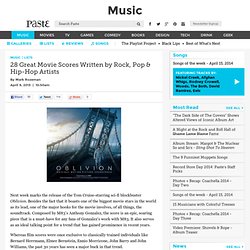
Besides the fact that it boasts one of the biggest movie stars in the world as its lead, one of the major hooks for the movie involves, of all things, the soundtrack. Composed by M83’s Anthony Gonzalez, the score is an epic, soaring piece that is a must-have for any fans of Gonzalez’s work with M83. It also serves as an ideal talking point for a trend that has gained prominence in recent years. Whereas film scores were once exclusive to classically trained individuals like Bernard Herrmann, Elmer Bernstein, Ennio Morricone, John Barry and John Williams, the past 30 years has seen a major buck in that trend. Today, it’s not uncommon for filmmakers to bring in rock, soul, electronic or even hip-hop artists to create the sound of their film. The following list will pick out some of the exceptional film work demonstrated by some our favorite musicians. 28. 27. 26. 25. 24. 23. 22. 21. 20. 19. 18.
Mputer-designed-by-scientists-to-compose-music-which-makes-the-brain-feel-happy-8507437. Researchers, who believe the mood-altering music-writing software can help combat stress and depression, will unveil the first composition created by the project at a music festival in Plymouth tomorrow.

(Sat) The project is being led by Dr Eduardo Miranda, a composer and professor at Plymouth University’s Interdisciplinary Centre for Computer Music Research (ICCMR), and Dr Slawomir Nasuto, a professor in the Cybernetics Research Group at the University of Reading. Using Artificial Intelligence techniques, the computer will play music and analyse the brain activity of the listener for emotional indicators. Based on this feedback, and a programmed knowledge of music, it will generate new sounds that can alter these emotions.
Jazz. Pattern music. Josquin des Prez. 1611 woodcut of Josquin des Prez, copied from a now-lost oil painting done during his lifetime[1] Josquin des Prez (or Josquin Lebloitte dit Desprez; French: [ʒɔskɛ̃ depʁe]; c. 1450/1455 – 27 August 1521), often referred to simply as Josquin, was a Netherlandish composer of the Renaissance.

Douleur me bat (Josquin des Prez, paintings by Hieronymus Bosch) John Dowland. This article is about the English musician.
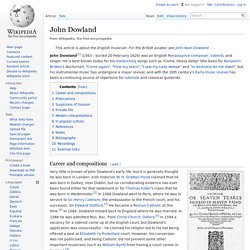
For the British aviator, see John Noel Dowland. Career and compositions[edit] Two major influences on Dowland's music were the popular consort songs, and the dance music of the day.[13] Most of Dowland's music is for his own instrument, the lute.[14] It includes several books of solo lute works, lute songs (for one voice and lute), part-songs with lute accompaniment, and several pieces for viol consort with lute.[15] The poet Richard Barnfield wrote that Dowland's "heavenly touch upon the lute doth ravish human sense. " One of his better known works is the lute song "Flow my tears", the first verse of which runs: Flow my tears, fall from your springs, Exil'd for ever let me mourn; Where night's black bird her sad infamy sings, There let me live forlorn. Dowland's song, "Come Heavy Sleepe, the Image of True Death", was the inspiration for Benjamin Britten's "Nocturnal after John Dowland for guitar", written in 1964 for the guitarist Julian Bream.
Giovanni Pierluigi da Palestrina - Wikipedia, the free encyclope. Giovanni Pierluigi da Palestrina Giovanni Pierluigi da Palestrina (c. 1525 – 2 February 1594)[1] was an Italian Renaissance composer of sacred music and the best-known 16th-century representative of the Roman School of musical composition.[2] He has had a lasting influence on the development of church music, and his work has often been seen as the culmination of Renaissance polyphony.[2] Biography[edit]
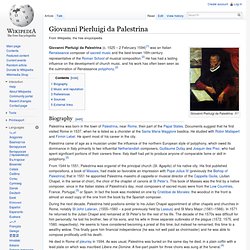
The Tallis Scholars sings Palestrina. Erik Satie. Éric Alfred Leslie Satie (French: [eʁik sati]; 17 May 1866 – 1 July 1925) — he signed his name Erik Satie after 1884 — was a French composer and pianist.
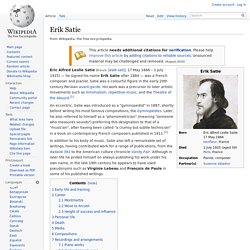
Satie was a colourful figure in the early 20th century Parisian avant-garde. His work was a precursor to later artistic movements such as minimalism, repetitive music, and the Theatre of the Absurd.[1] Erik Satie - Gnossienne No.5. Les six. The members were: Les nouveaux jeunes[edit] Les Six[edit]
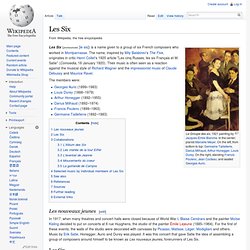
Germaine Tailleferre. Germaine Tailleferre and Mario Hacquard Germaine Tailleferre (French: [tɑjfɛʁ]; 19 April 1892 – 7 November 1983) was a French composer and the only female member of the group of composers known as Les Six.

Biography[edit] She was born Marcelle Taillefesse at Saint-Maur-des-Fossés, Val-de-Marne, France, but as a young woman she changed her last name to "Tailleferre" to spite her father, who had refused to support her musical studies. Moretti plays Tailleferre Sonata. Francis Poulenc. Francis Jean Marcel Poulenc (French: [fʁɑ̃sis ʒɑ̃ maʁsɛl pulɛ̃k]; 7 January 1899 – 30 January 1963) was a French composer and pianist, associated with the French group Les Six. He composed art songs, solo piano music, chamber music, oratorios, choral music, operas, ballet music, and orchestral music.
Early life and education[edit] Francis Poulenc - Ave verum corpus. Poulenc Two Piano Concerto First Movement. Francis Poulenc. Louis Durey. Louis Durey (French: [dyʁɛ]; 27 May 1888 – 3 July 1979)[1] was a French composer. Life[edit] Louis Durey was born in Paris, the son of a local businessman. It was not until he was nineteen years old that he chose to pursue a musical career after hearing a performance of a Claude Debussy work. As a composer he was primarily self-taught. From the beginning, choral music was of great importance in Durey’s productivity.
Durey communicated with his colleague, Darius Milhaud, and asked him to contribute a piano piece that would bring together the six composers who, in 1920 were dubbed Les Six. After the Les Six period, Durey continued with his career. In the late 1950s and early 1960s he continued to compose but produced nothing of significance. Louis Durey - Deux Pièces pour piano à 4 mains Op. 7 - I. Carill. Germaine Tailleferre. Darius Milhaud. Darius Milhaud (about 1926), Paris Darius Milhaud (French: [daʁjys mijo]; 4 September 1892 – 22 June 1974) was a French composer and teacher. He was a member of Les Six—also known as The Group of Six—and one of the most prolific composers of the 20th century. His compositions are influenced by jazz and make use of polytonality. Darius Milhaud is to be counted among the modernist composers.[1] Life and career[edit] Born in Marseilles to a Jewish family from Aix-en-Provence, Milhaud began as a violinist, later turning to composition instead. On his return to France, Milhaud composed works influenced by the Brazilian popular music he had heard, including compositions of Brazilian pianist and composer Ernesto Nazareth.
Darius Milhaud "La création du monde" part 1. How the Ox got on the Roof. The Song from Moulin Rouge. History[edit] The music was written by Georges Auric. The original French lyrics were by Jacques Larue, the English words by William Engvick. However, in the film the song is called "It's April Again", and there is no mention of the phrase "Where Is Your Heart". Percy Faith - The song from Moulin Rouge. Georges Auric. Georges Auric Georges Auric (French: [ɔʁik]; 15 February 1899 – 23 July 1983) was a French composer, born in Lodève, Hérault. He was an early film composer and considered one of Les Six, a group of artists informally associated with Jean Cocteau and Erik Satie.[1] Before he turned 20 he had orchestrated and written incidental music for several ballets and stage productions.
Early life and education[edit] Georges Auric began his musical career at a young age, performing a piano recital at the Société Musicale Indépendante at the age of 14. Georges Auric - Une valse, for two pianos. La Bella y la Bestia (1946) - Trailer original de cine. Arthur Honegger. Honegger on the 1996 Swiss 20 franc note. Arthur Honegger (French: [aʁtyʁ ɔnɛɡɛːʁ]; 10 March 1892 – 27 November 1955) was a Swiss composer, who was born in France and lived a large part of his life in Paris.
He was a member of Les Six. Honegger Cello Concerto Pt.1. Erik Satie et le Groupe des Six. AARON COPLAND - PIANO BLUES NO. 4, WITH BOUNCE. Ralph Vaughan Williams. Ralph Vaughan Williams OM (/ˌreɪf ˌvɔːn ˈwɪljəmz/;[1] 12 October 1872 – 26 August 1958) was an English composer of symphonies, chamber music, opera, choral music, and film scores. He was also a collector of English folk music and song; this collecting activity influenced both his editorial approach to the English Hymnal, in which he included many folk song arrangements as hymn tunes, and several of his own original compositions.
Ralph Vaughan Williams: Tallis Fantasia. Igor Stravinsky. Igor Stravinsky : Agon (1/2) Kyung Wha Chung plays Stravinsky Violin Concerto (4th Mov)